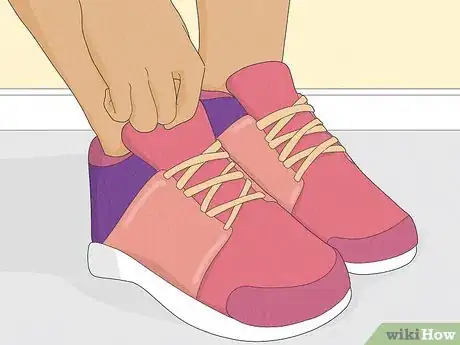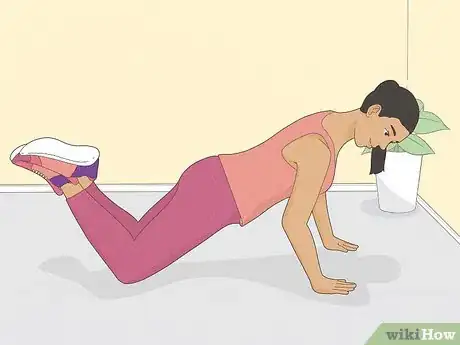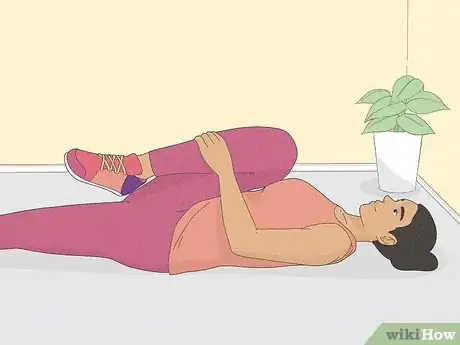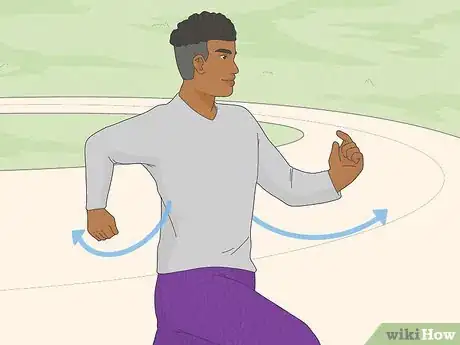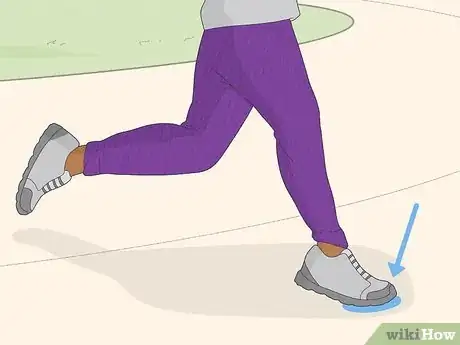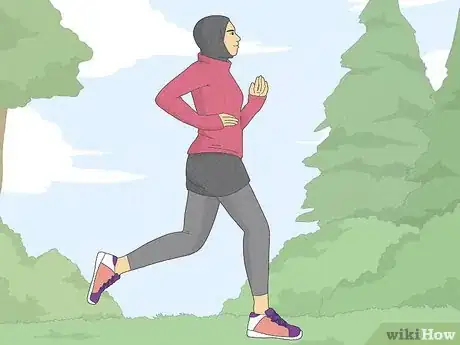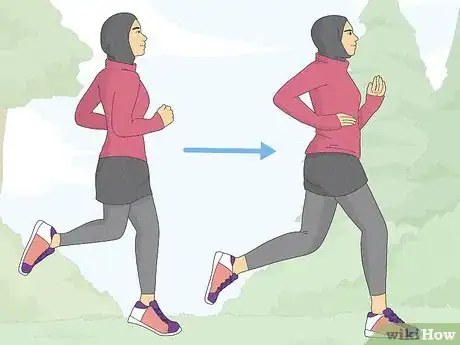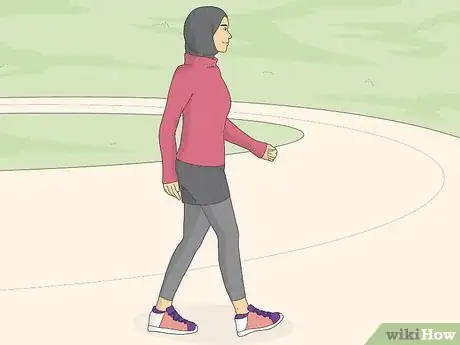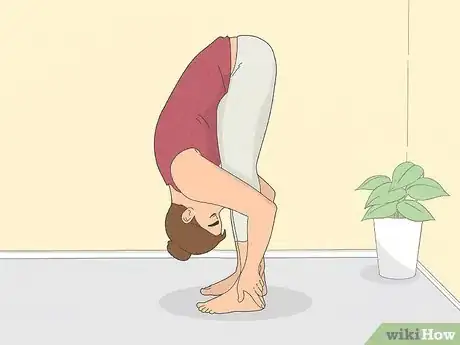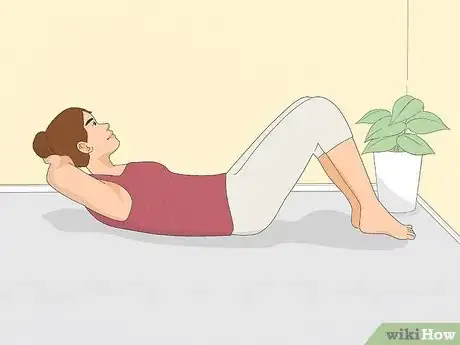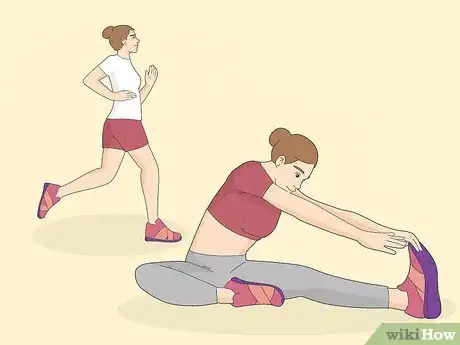This article was co-authored by Francisco Gomez. Francisco Gomez is the Head Coach at the FIT Potato Gym, a training gym established in 2001 in the San Francisco Bay Area. Francisco is a former competitive runner who helps endurance athletes train for major marathons like the Boston Marathon. Francisco specializes in Injury Rehab, Flexibility, Marathon Training, and Senior Fitness. He has a B.S. in Nutrition and Exercise Physiology & Running.
There are 11 references cited in this article, which can be found at the bottom of the page.
This article has been viewed 5,535 times.
Back pain while running can really put the brakes on your exercise routine, especially if it’s an activity you enjoy. But it doesn’t have to be that way. In fact, a regular run can help heal back pain by keeping you active and strong.[1] However, like any other exercise, you have to do it correctly to avoid injuries. Preventing back pain while you’re running only requires some simple adjustments, so get started today!
Steps
Before You Run
-
1Wear comfortable, supportive running shoes. Good running shoes are a huge part of staying healthy while you run. Without proper support, your back will absorb a lot of impact. Get shoes with good padding and support to take the strain off your back. They should feel comfortable and not rub against your feet and cause blisters.[2]
- Replace your running shoes whenever they start wearing out because they won’t be as supportive anymore. A general rule is to get new shoes every 250 mi (400 km), but judge by the condition of the shoes.
- If you often get blisters on your feet, rubbing some petroleum jelly on trouble spots can help prevent that.
-
2Warm up to get your muscles ready for running. If you start running before you’re warmed up, your muscles could tense and tighten, causing back pain. Do a thorough warmup for 5-10 minutes before your run. Light cardio activities like walking, jumping rope, or jumping jacks get your heart rate up and loosen your muscles before a run.[3]
- Some light strength exercises like pushups or yoga can also work as a warmup routine.
- Don’t stretch before you warm up. Your muscles aren’t very flexible when they’re cold.
-
3Stretch your back and hamstrings after warming up. Tight muscles in your back and legs are a major cause for pain while running. After your warmup, do a good stretching routine, focusing especially on your hips flexors, your hamstrings, and your glutes.[4] Keeping them nice and flexible can help prevent pain during and after your run.[5]
- A simple stretch is bending down to touching your toes. Hold that for a few seconds to loosen your lower back, glutes, and hamstrings.
- For a deeper leg and back stretch, lay on your back. Bend one leg up and pull it towards your chest. Hold that for a few seconds to loosen your glutes and lower back, then switch sides.
- A cat and cow pose from yoga is also helpful for loosening your lower back.
Form and Posture
-
1Keep your back straight and your shoulders back while running. Bad form can put more pressure on your back and trigger pain. When you’re running, keep your back straight and your shoulders back. Push your chest out so you don't hunch forward. This takes pressure off your back.[6]
- Whether you’re running fast or lightly jogging, good form is always important. Follow this no matter how hard you’re working out.
- If you’re not sure about your running form, try talking to a coach or trainer for some pointers.
-
2Pump your arms back and forth instead of side to side. Pumping your arms across the center of your body makes your back twist in an unnatural way, which could cause pain. Focus on pumping straight up and down. This keeps your back straight.[7]
- If you need a reminder to pump your arms straight, try to tap your hand against your shoulder on the same side when you lift your arms. This forces you to keep your arms moving up and down.
-
3Land on the balls of your feet to decrease the impact on your back. Many runners use the heel-to-toe technique, but this actually increases the impact on your joints and lower back. Instead, use the forefoot technique. Come down on the balls of your feet instead of your heels. This reduces the impact and is much easier on your back.[8]
- This does put more stress on your calves though, so be prepared for sore calves for a few weeks while you get used to this style.
- Taking smaller strides can also reduce the stress on your back and joints. If you tend to take very big steps, try shortening your stride.
Good Habits
-
1Run on a soft surface like grass or a track if you can. Hard surfaces like concrete or asphalt are tough on your joints and back. If you can, try to run on softer surfaces like grass, a trail, or a rubber track. This reduces the impact on your joints and can help you avoid more pain.[9]
- Treadmills are also good running surfaces if you have one in your home or gym.
- If you live in the city, then you probably don't have a choice for where you run. In this case, just make sure to wear shoes with good support and practice good form while you're running.
-
2Start slowly and gradually build your speed. Starting at top speed can shock your muscles, even if you’ve warmed up and stretched. Start with a slow jog or even a walk, and increase your speed gradually. Reaching your top speed slowly puts less stress on your muscles and prevents back strains.[10]
- This is especially important if you’re not used to running or are healing from an injury.
- If at any point your back starts hurting, ease back on the speed. Find a comfortable pace that doesn’t hurt.
- Try to keep exercising every day, even if you feel sore. If you don't move, you'll actually hurt more, because your joints will get stiff.[11]
-
3Cool down so your muscles don’t tighten up. A good cool-down is just as important as a warmup. When you’re done running, walk for another few minutes to help your muscles relax. Then stretch your back and hamstrings again to get rid of any tension that built up during your run.[12]
- A good way to think about your cool down is the reverse of your warmup. Instead of running gradually faster, run gradually slower and stretch after.
-
4Stretch your back and hamstrings every day. Staying flexible at all times is important for preventing pain while you run. Do the same back and hamstring stretches twice a day, even if you aren’t running. This reduces strain and tension on your lower back.[13]
- Making yoga or tai chi a part of your daily schedule is great for flexibility. You can do these activities on days that you don’t run to stay loose.
- If your back is sore, try massaging your glutes and the muscles in your back with a foam roller or a lacrosse ball.[14]
-
5Strengthen your core muscles to support your back. You might not realize it, but your core muscles support the rest of your body while you run. If they’re weak, the stress all falls on your back. Incorporate core strengthening exercises into your regimen to take the pressure off your back while you run.[15]
- Isolation muscles like planks and side bridges are better for core strengthening than sit-ups or crunches. Make these a part of your workout routine.
-
6Practice cross-training so your muscles don’t get overused. Cross-training means doing a variety of different exercises. If you only do one type of exercise, like running, those muscles will get overworked. This can cause all kinds of aches and pains, like in your lower back. Mix things up with a good cross-training routine so your muscles are all evenly worked.[16]
- For a sample schedule, do aerobic exercises like running 3 days a week, strength training 2 days a week, and some flexibility training every day. This mixes things up for even muscle development.[17]
- Don’t do the same exercise 2 days in a row. Switch off between strength and cardio each day.
Expert Q&A
-
QuestionWhy is my back stiff?
 Francisco GomezFrancisco Gomez is the Head Coach at the FIT Potato Gym, a training gym established in 2001 in the San Francisco Bay Area. Francisco is a former competitive runner who helps endurance athletes train for major marathons like the Boston Marathon. Francisco specializes in Injury Rehab, Flexibility, Marathon Training, and Senior Fitness. He has a B.S. in Nutrition and Exercise Physiology & Running.
Francisco GomezFrancisco Gomez is the Head Coach at the FIT Potato Gym, a training gym established in 2001 in the San Francisco Bay Area. Francisco is a former competitive runner who helps endurance athletes train for major marathons like the Boston Marathon. Francisco specializes in Injury Rehab, Flexibility, Marathon Training, and Senior Fitness. He has a B.S. in Nutrition and Exercise Physiology & Running.
Fitness Coach A lot of times if your back is stiff, it's because your hip flexors, hamstrings, and glutes are tight. Focus on stretches that will work those areas, as well as back and posture stretches. You can also release your glutes with a lacrosse ball or foam roller.
A lot of times if your back is stiff, it's because your hip flexors, hamstrings, and glutes are tight. Focus on stretches that will work those areas, as well as back and posture stretches. You can also release your glutes with a lacrosse ball or foam roller.
Warnings
- If you have persistent back pain, it's best to see your doctor for a checkup. You might have an injury that needs to be addressed, and it could get worse if you ignore it.⧼thumbs_response⧽
References
- ↑ https://health.clevelandclinic.org/how-running-can-benefit-your-back/
- ↑ https://www.runnersworld.com/uk/health/injury/g771058/injury-runners-lower-back-pain/
- ↑ https://www.health.harvard.edu/staying-healthy/exercise-101-dont-skip-the-warm-up-or-cool-down
- ↑ Francisco Gomez. Fitness Coach. Expert Interview. 25 October 2019
- ↑ https://www.runnersworld.com/health-injuries/a19577588/lower-back-pain/
- ↑ https://www.runnersworld.com/beginner/a20811257/proper-running-form-0/
- ↑ https://www.runnersworld.com/beginner/a20811257/proper-running-form-0/
- ↑ https://youtu.be/bIrRC9kqn40?t=174
- ↑ https://www.runnersworld.com/uk/health/injury/a760152/top-10-running-surfaces/
- ↑ https://health.clevelandclinic.org/how-running-can-benefit-your-back/
- ↑ Francisco Gomez. Fitness Coach. Expert Interview. 25 October 2019
- ↑ https://www.mayoclinic.org/healthy-lifestyle/fitness/in-depth/exercise/art-20045517
- ↑ https://www.runnersworld.com/health-injuries/a19577588/lower-back-pain/
- ↑ Francisco Gomez. Fitness Coach. Expert Interview. 25 October 2019
- ↑ Francisco Gomez. Fitness Coach. Expert Interview. 25 October 2019
- ↑ https://www.canr.msu.edu/news/the_benefits_of_adding_cross_training_to_your_exercise_routine
- ↑ https://orthoinfo.aaos.org/en/staying-healthy/cross-training
